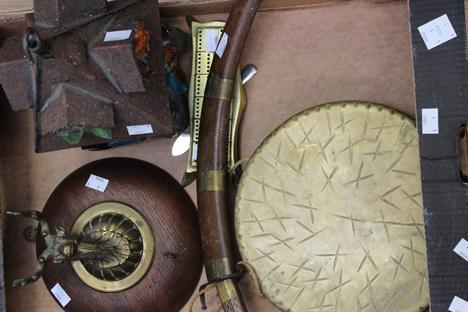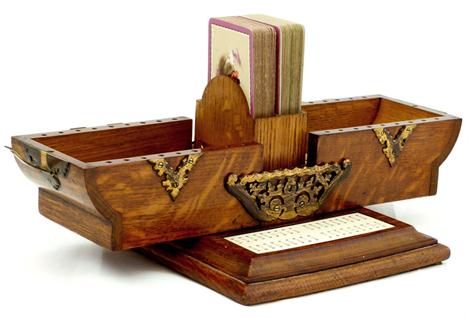We found 5589 price guide item(s) matching your search
There are 5589 lots that match your search criteria. Subscribe now to get instant access to the full price guide service.
Click here to subscribe- List
- Grid
-
5589 item(s)/page
Victorian mahogany rectangular games compendium, the hinged cover and two door front enclosing a fitted interior with two lift-out trays housing a boxwood chess set, draughts, cribbage board, whist markers, playing cards, Escalado markers, various gaming counters, dice and a chess / backgammon board
A Late Victorian Mahogany Bagatelle Table, by Orme & Sons, Manchester, late 19th century, the hinged lid opening to reveal a green velvet slate bed table, the sides fitted with two brass pockets and cribbage markers, raised on turned legs, 72cm by 123cm (246cm open) by 77cm Case with general scratches and some bruising, a reasonable colour throughout. Green velvet interior with one section very light in colour. Some staining near the bottom section. There should be an end section to fit on the end of the table when closed, this is missing. 140113
A good late Victorian oak cased games compendium, the hinged lid set with a folding chess/backgammon board above two lift-out trays for playing cards and draught pieces, the upper tray fitted with a cribbage board and with a Staunton chess set to the front section, both knights and both rooks stamped with a red crown, height of king 7cm. CONDITION REPORT: Both kings for the chess set have had the finials removed, presumably this is because they would not fit into the case with the finials present, this may indicate that they set in the box now is not the original. Light wear to the case, some surface scratches commensurate with age, overall a nice set.
A parcel lot to contain a wooden veneered chessboard, a box of turned wood chessmen by Staunton labelled J Jaques & Son ltd London to lid interior, a wood and bone veneered cribbage board and a boxed set of ebony and bone dominos with a pair of metal framed prints and a pressed brass vase with tavern scene
A quantity of miscellaneous items, 19th century and later, to include a treen and metal mounted tobacco pot and cover, two chocolate moulds of chicken form, a pair of silver plated candle holders with pierced shades, a carved wooden cribbage board, four green glass and gilt metal mounted door knobs, three gilt metal mounted picture frames, Oriental articulated gilt metal fish (a/f) and a gilt wooden frame, (a lot).
A Victorian games compendium 'The Royal Cabinet of Games' with hinged bevelled edge glass top, the interior fitted three compartments and hinged doors with complete Staunton pattern bone chess set in red and white, draughts, cribbage board, dominoes, the racing game and various counters, dice etc, complete with folding board, the compendium 34cm (13.25") wide/see illustration
Australia & New Zealand 1910. A well written Edwardian journal recording a six month trip by Englishman William Lucas, containing over 75 loosely inserted or tipped-in pieces of original printed ephemera collected on the trip, written in two journals in ink in a neat hand on 81 and 97 pages respectively on the rectos only, the first journal concerning Australia, the second New Zealand, all pages present, a few detached and creased, the loosely inserted ephemera including hotel receipts & business cards, picture house programmes, a Chinese laundry price list and receipt, a signed permit to visit the Victorian Railways workshop at Melbourne, 2 Parramatta Ferry tickets, Upper Cove Ferry ticket, 4 Melbourne tram tickets, Barracluff’s Ostrich Farm business card and postcard, printed menu cards, luggage tags and tickets, Blackheath School of Arts membership form, Medlow Bath ticket, New Zealand Shipping Co. SS “Ruahine” receipt, permit to inspect institutions in Sydney, SS Wimmera menu card, an engraved RMS Turakina list of passengers, Tuhourangi Maori Troupe programme, 2 Maori guide business cards (Whakarewarewa & Okere Falls), pack of Orient Line playing cards, dining room passes, and other printed epehemera. William Lucas (born 1844 Clapham) was a publishers agent who, at the age of 66 and presumably after retirement, set off on a six month trip to Australia and New Zealand aboard the steamship “Ruahine” arriving in Melbourne on 30 October 1910 and finding the city full of visitors for the Melbourne Cup which Lucas attends “The sight was well worth the money, there was plenty of seats under the trees and many husbands bought their wives and families for a picnic...every hotel was packed and they don’t seem to mind what they spend”. On a visit to “The Book Lover” bookshop he meets the wife of the influential socialist Henry Hyde Champion (1859-1928) and is invited to meet Hyde at his house where he tells Lucas about the Trafalgar Day riots and his subsequent prison sentence. Lucas also visits the Melbourne Federal Houses of Parliament and sees Billy Hughes (1862-1952) speak, and describes visits to many Melbourne suburbs including St Kilda, Mornington, the tents at Mordialloc, Spotswood Glass Works, etc. In Sydney he takes several boat tours and visits the spot where Lady Fitzroy (wife of Governor Sir Charles Fitzroy) was killed - “while I was looking at the monument a young man came up, he was the son of a farmer and...told me his father said Sir Charles Fitzroy was driving the carriage and he was mad drunk at the time...Sir Charles carried on with the landlord’s daughter while his wife was laying there [dying] and it became such a scandal that the landlord kicked him into the street soon after”. Lucas is also told an interesting story about Sir John Henniker Heaton (1848-1914) who had once worked for the teller’s grandfather in very straightened circumstances. He also observes “surf bathing” at Bondi and Manly beaches and while visiting La Perouse’s memorial enters a nearby aborigine reservation “got talking to one of the men who had a boomerang in his hand, he said he would teach me how to throw it...it rose in the air to about 30 feet and made two complete circles...”. Lucas is very sociable and strikes up converstaions and friendships with many people he meets. He observes the fashion in Sydney for gold dental fillings and starts to incorporate Australian slang in his own journal including swagman, back-blocker, mate, cornstalk, etc. A man at Coogee Bay tells him “Australia was the land for the working classes...the men talk to the bosses not the other way about as in the old country”. He spends Christmas week in the Blue Mountains and enjoys trips organised by butcher Nick Delaney of Blackheath who tells him “one Christmas he sat down to dinner with 25 blacks in Western Australia and there was not another white man within a hundred miles”. Upon arriving in Auckland he observes that the Maori women “after 30 get very fat and tubby, the girls dress in the height of fashion that was in vogue 10 years ago”. He spends some time among the hot geysers and springs at Rotorua and Whakarewarewa and is shown around by Maori guides, describing the Kaka and many Maori people and customs. At Wellington he befriends Mr L.H. Fox, the House Steward of Wellington Hospital, and enjoys many evenings with him playing cribbage. While in Wellington he tours the huge Gear Meat Co. and provides a long description of the industrial process of slaughtering sheep. He finally travels home on the SS Turakina, via Montevideo and Rio de Janeiro, interestingly meeting a Mr Maloney on board who was returning to County Sligo after 37 years in Australia and who knew Ned Kelly and provides a description of Kelly’s capture. Lucas arrives in London on 27 March 1911. (-)
An inlaid wooden games box with lidded central compartment, and contents of four marking pegs, pack of Thomas De La Rue & Co Ltd Pierrot playing cards, pack of linen finish playing cards, and two Chas Goodall & Son Whist Markers; together with two boxes of bone and ebony dominoes and a brass cribbage board
A Late 19th/ Early 20th Century Scrimshaw Work Walrus Tusk Cribbage Marker, one side well decorated with an Inuit roping a caribou, the cribbage board flanked by suits of diamond, heart, club and spade, and a polar bear, the opposing side with a walrus, a hare and two beavers, one caught in a gin trap, 42cm
A Victorian walnut games and work table, the rectangular quarter veneered top with bowed ends, turning and folding, enclosing chess, backgammon and cribbage, above one long drawer and D-shaped basket, leaf carved turned end supports, turned stretcher, leaf carved cabriole legs, knurl feet, ceramic casters, 63cm wide, 75cm high, c.1860 burr walnut games table some very slight damage - loss of veneer - see images, otherwise in very good condition
A mid 19th century Irish Killarney marquetry and yew wood games table, the hinged top centered with a paterae of Muckross abbey flanked by furnes within a band of foliate marquetry and a enclosing backgammon, cribbage and chest boards, within thistle and clover banded reserves, raised on a faceted baluster column, qudrapartite base with claw feet, 74cm high x 78cm wide.
-
5589 item(s)/page

























































